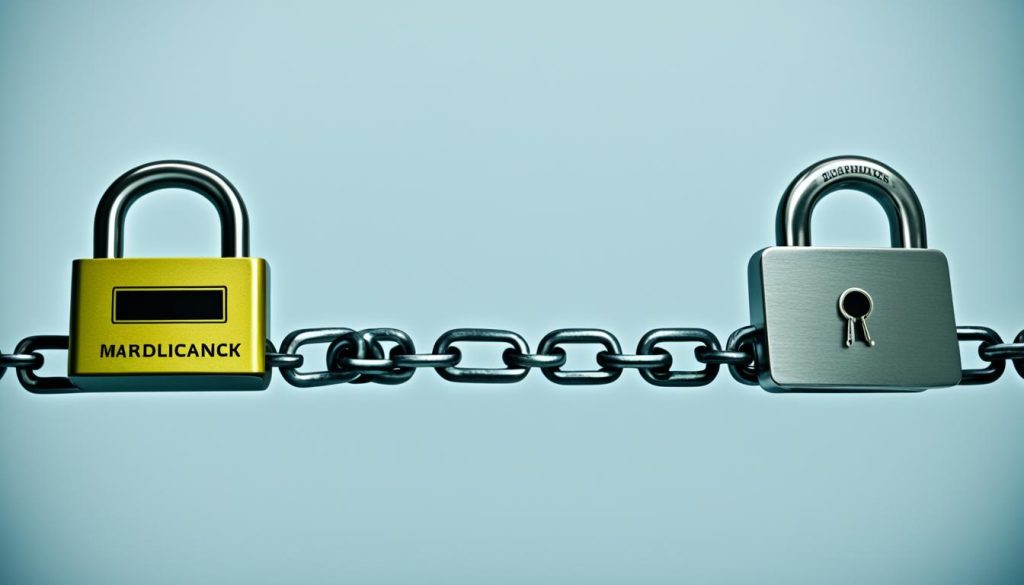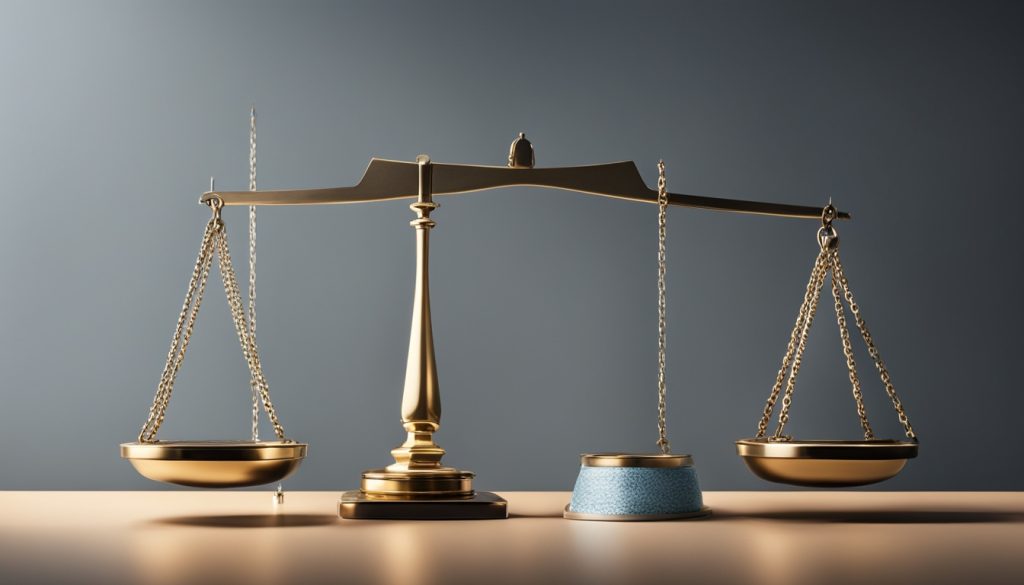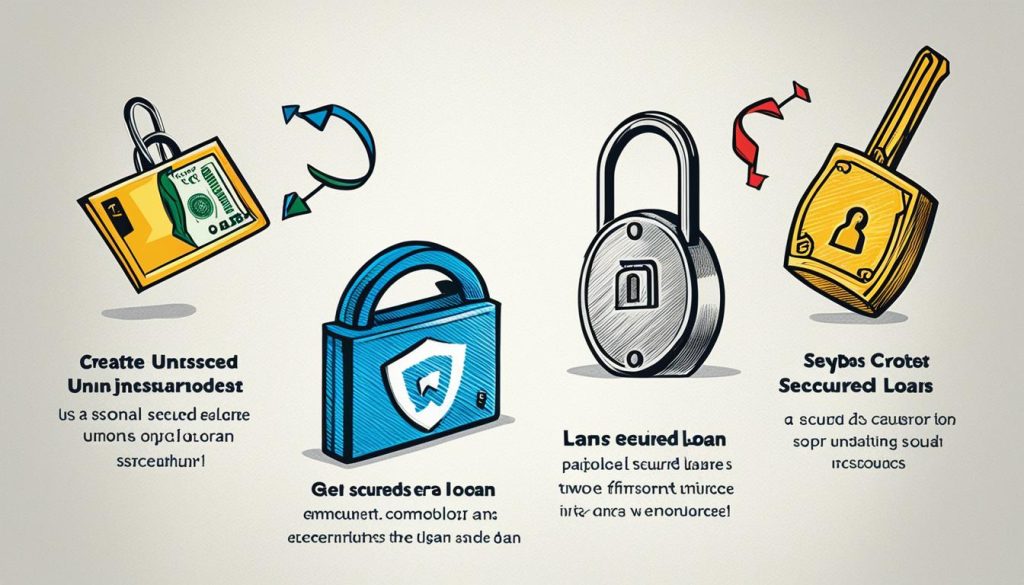Personal loans come in two main types: secured and unsecured. These loans differ in many ways, like collateral needs, interest rates, and how much you can borrow. Knowing the differences between secured and unsecured loans can help you pick the right one for your financial needs.
Key Takeaways
- Secured personal loans require collateral, while unsecured loans do not.
- Secured loans may offer lower interest rates but require an asset as security.
- Unsecured loans have higher interest rates but are more accessible to borrowers with limited collateral.
- Credit score and income are critical factors in qualifying for both secured and unsecured personal loans.
- The choice between secured and unsecured loans depends on your financial situation and preferences.
Understanding Secured and Unsecured Personal Loans
There are two main types of personal loans: secured and unsecured. Knowing the differences helps you choose the right loan for your needs.
Defining Secured Loans
A secured loan requires you to offer something valuable as collateral. This could be a car, home, or investment account. If you can’t pay back the loan, the lender can take your collateral.
Secured loans usually have lower interest rates and you can borrow more money. This is because the collateral makes the lender less risky.
Defining Unsecured Loans
Unsecured loans don’t need collateral. The lender looks at your creditworthiness, including your credit score and income. These loans, like personal loans and credit cards, are more common than secured loans.
They have higher interest rates and you can’t borrow as much. But, you don’t have to give up any assets as collateral.
| Feature | Secured Loans | Unsecured Loans |
|---|---|---|
| Collateral | Required | Not required |
| Interest Rates | Lower | Higher |
| Borrowing Limits | Higher | Lower |
| Qualifying Criteria | Based on collateral and creditworthiness | Based solely on creditworthiness |
The main difference between secured loans and unsecured loans is collateral. Its presence affects the loan’s terms and conditions.
Key Differences Between Secured and Unsecured Loans
There are two main types of personal loans: secured and unsecured. The main difference is in the collateral needed, interest rates, and how much you can borrow. Knowing these differences helps you choose the right loan for your needs.
Collateral Requirements
Secured loans need you to offer something valuable as collateral, like a car or a house. If you can’t pay back the loan, the lender can take your collateral. Unsecured loans don’t need collateral, making them safer for you but riskier for the lender.
Interest Rates and Borrowing Limits
Secured loans usually have lower interest rates because they’re seen as less risky. They also have higher borrowing limits. Unsecured loans have higher interest rates and lower borrowing limits because they’re riskier for lenders.
The interest rates and borrowing limits depend on your credit score and debt-to-income ratio. A good credit and low debt make you more likely to get lower interest rates and higher borrowing limits, for both secured and unsecured loans.
“The key difference between secured and unsecured loans is the collateral requirement. Secured loans require an asset as collateral, while unsecured loans do not.”
In summary, the main differences between secured and unsecured loans are in the collateral needed, interest rates, and borrowing limits. Understanding these can help you pick the best loan for your financial goals.

Process for Secured vs. Unsecured Loans Personal Loans
Getting a personal loan is a big step towards reaching your financial goals. You might be looking at a secured or unsecured loan. Knowing how each process works can help you choose wisely. Let’s look at the main differences between them.
Secured Loan Application Process
First, you need to offer something valuable as collateral, like a car, savings, or investment. The lender checks how much your collateral is worth and looks at your credit score, income, and debt-to-income ratio. They use this info to figure out how much to lend you and what interest rate to charge.
This process might take a bit longer because the lender has to check the collateral before saying yes to the loan.
Unsecured Loan Application Process
Unsecured loans are different. They don’t need collateral. Instead, lenders look at your credit profile and financial info. They use this to decide how much to lend you and what interest rate to charge.
These loans can be funded quickly, sometimes even the same day, because there’s no need to check collateral.
Knowing how secured and unsecured loans work can make applying for one easier. It helps you pick the right one for your financial situation and what you prefer.
“Choosing the right personal loan can be a game-changer in your financial journey. Take the time to understand the application process and make the decision that best suits your needs.”
Qualifying for Secured and Unsecured Personal Loans
Getting a personal loan, whether secured or unsecured, means meeting certain criteria. Lenders look at your credit score, income, and debt-to-income ratio to decide if you’re eligible.
Credit Score and Income Requirements
Secured personal loans often have easier credit score requirements than unsecured loans. This is because you offer collateral, which reduces the lender’s risk. But, they still check your credit history, score, and income to make sure you can pay back the loan. A credit score of 670 or higher is usually wanted, but some lenders might accept lower scores if your collateral is valuable.
Unsecured personal loans focus more on your creditworthiness. Lenders closely examine your credit score, which is key in their decision. If your FICO score is 670 or above, you’re more likely to get good interest rates and terms. They’ll also look at your income and debt-to-income ratio to see if you can afford the monthly payments.
Remember, different lenders have their own credit score and income needs. So, it’s smart to compare offers before applying for a personal loan.

“Securing a personal loan requires a careful consideration of your financial situation and the lender’s criteria. Understanding the differences between secured and unsecured loans can help you make an informed decision that best fits your needs.”
Advantages and Disadvantages of Secured and Unsecured Loans
When looking at personal loans, you have to choose between secured and unsecured loans. Each type has its own pros and cons. It’s key to know these before you decide.
Advantages of Secured Loans
- Typically lower interest rates: Secured loans, which need collateral, usually have lower interest rates than unsecured loans.
- Higher borrowing limits: With secured loans, you can borrow more money. The collateral makes the lender feel safer.
- Easier qualification for borrowers with lower credit scores: Even if your credit score is low, you might get a secured loan. The collateral lowers the lender’s risk.
Disadvantages of Secured Loans
- Risk of losing collateral: The big risk of a secured loan is losing the collateral if you can’t pay back the loan. This could be something valuable like a home or a car.
Advantages of Unsecured Loans
- No risk to personal assets: Unsecured loans don’t need collateral. So, your assets are safe even if you can’t repay the loan.
- Greater flexibility in how funds are used: You can spend the money from an unsecured loan however you want. There are no rules on how you use it.
Disadvantages of Unsecured Loans
- Higher interest rates: Unsecured loans usually have higher interest rates. This is because they’re seen as riskier for lenders.
- More difficult to qualify: If your credit score is poor, getting an unsecured loan might be harder. Lenders are more careful without collateral.
The choice between a secured or unsecured loan depends on your financial situation, credit score, and if you’re willing to offer collateral. Knowing the good and bad points of each can help you make a choice that fits your needs and goals.

Conclusion
Secured and unsecured loans are two main options in personal financing. Each has its own benefits and things to think about. Secured loans need collateral and can offer lower interest rates and higher borrowing limits. But, you could lose your assets if you can’t pay back the loan.
Unsecured loans don’t need collateral but have higher interest rates and stricter rules to qualify. When choosing between them, think about your financial needs, credit score, and if you’re okay with risking an asset.
It’s smart to compare rates and fees from different lenders. This way, you can pick the loan that matches your financial goals. Whether it’s for debt consolidation, a big purchase, or unexpected expenses, knowing the differences between secured and unsecured loans helps you make a smart choice. This way, you can get a loan that suits your financial situation and goals.
FAQ
What is the difference between secured and unsecured personal loans?
Secured loans need you to offer something valuable as collateral. If you don’t pay back the loan, the lender can take this asset. Unsecured loans don’t ask for any collateral.
How do the interest rates and borrowing limits differ between secured and unsecured personal loans?
Secured loans usually have lower interest rates because the lender takes less risk. They also let you borrow more money because the collateral helps cover the risk. Unsecured loans have higher interest rates but don’t risk your assets.
What is the process for obtaining a secured personal loan compared to an unsecured personal loan?
For a secured loan, you need to offer something valuable as collateral. The lender checks the collateral’s value and your credit to set the loan amount and interest. Secured loans might take a bit longer to get approved and funded.
Unsecured loans look only at your credit and finances, without needing collateral. They can be funded faster.
What are the credit score and income requirements for secured and unsecured personal loans?
To get a secured loan, lenders look at your credit score, history, income, and debt-to-income ratio, plus the collateral’s value. Secured loans might be easier to get if your credit isn’t perfect.
For an unsecured loan, the lender mainly checks your creditworthiness. They focus on your credit score and how much debt you have compared to your income.
What are the advantages and disadvantages of secured and unsecured personal loans?
Secured loans have lower interest rates, can borrow more money, and are easier to get with a lower credit score. But, you could lose the collateral if you don’t pay back the loan.
Unsecured loans don’t need collateral, so you don’t risk your assets. But, they have higher interest rates and are harder to get, especially with bad credit.

